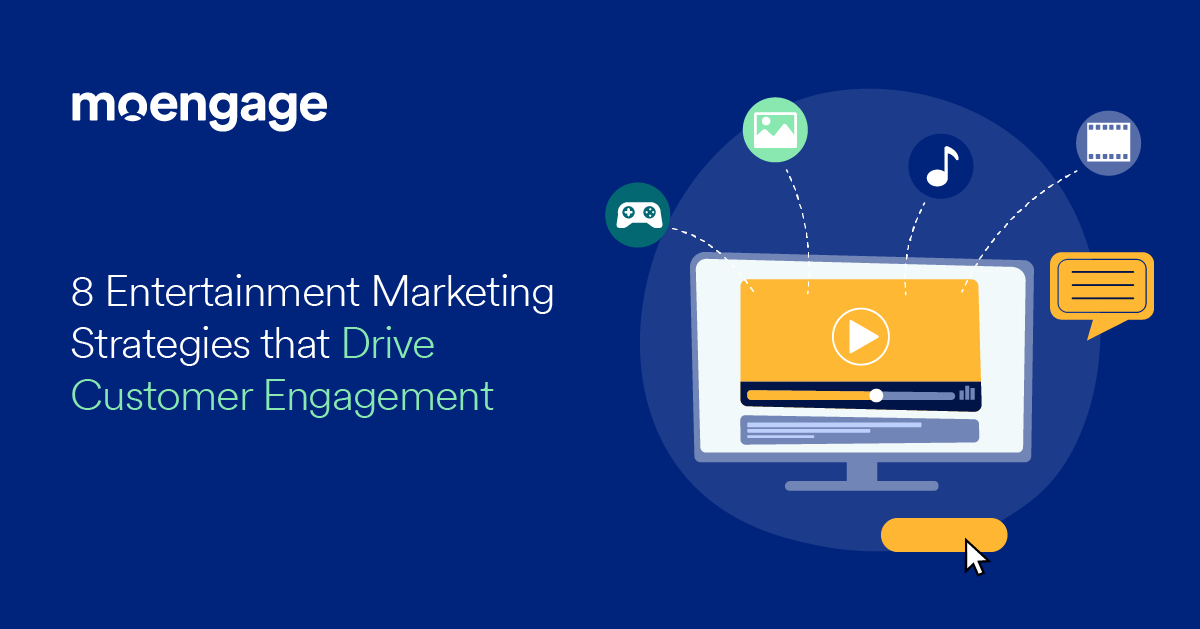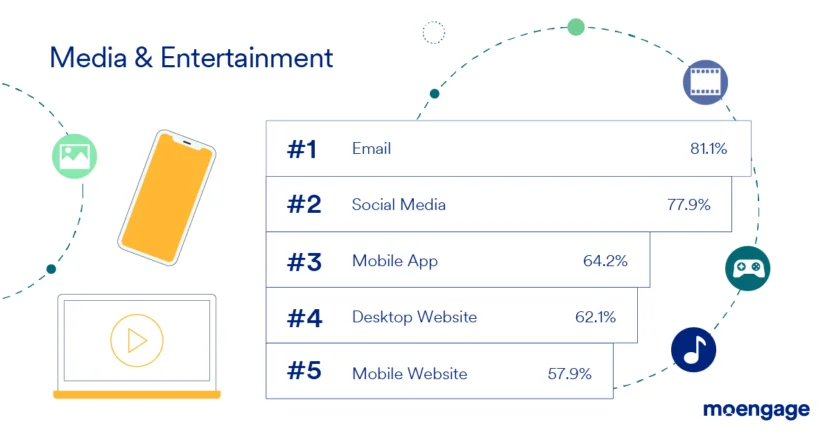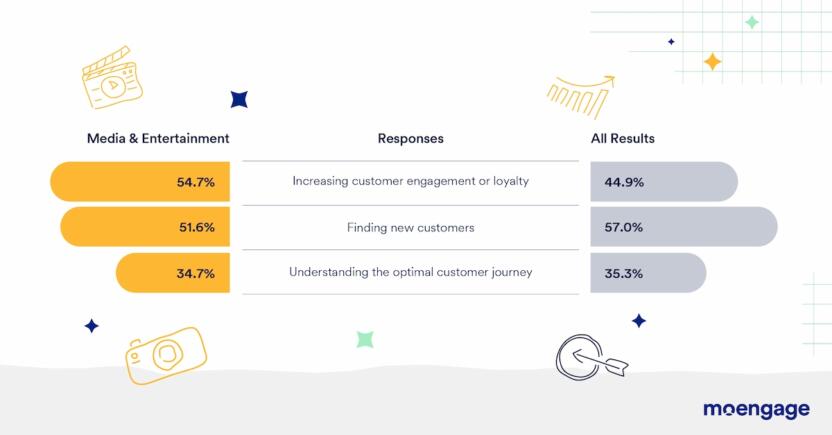8 Entertainment Marketing Strategies that Drive Customer Engagement

Reading Time: 12 minutes
In the Media & Entertainment industry, eliciting conversions and driving revenue is all about capturing and channeling customer attention. But as attention spans get shorter and the list of available options gets longer, it becomes increasingly harder to capture that attention.
This trend is only exacerbated in an industry that depends on customer attention to not only thrive — but survive.
Media & Entertainment marketers must provide best-in-class experiences that effectively showcase their products, capture customer attention, and increase engagement. After all, the objective isn’t to generate a one-time view or listen, but rather to influence consumer behavior by creating a platform or brand experience that becomes habit-forming, compelling people to continuously engage over time.
According to our survey of Media & Entertainment marketers, most understand this. The top objective of many (54.7%) is to increase customer engagement or loyalty. They know that if they focus intently on increasing customer engagement and satisfaction, they’ll naturally meet their core objective of increasing impressions (and ultimately, revenue), whether that’s through merchandise sales, subscriptions, renewals, ad revenue, or affiliate marketing.
In this article, we explore how M&E brands can implement entertainment marketing strategies that drive customer engagement.
What is an Entertainment Marketing Strategy?
An entertainment marketing strategy is focused on cultivating long-term relationships between brands and individuals that fuel consistent, active customer engagement. It involves analyzing customer activity and behavior to understand their needs and preferences and then leveraging these insights to deliver personalized experiences and marketing campaigns that drive engagement.
Whether you’re a mobile gaming company, a live streaming platform, a music streaming service, or any other type of media brand, entertainment marketing strategies empower you to connect with your audience, promote relevant content, send personalized messaging, and activate your customers to engage online and in real life.
With the right campaign, your brand can attract customer attention to increase the value of your advertising, sell tickets to live events, or motivate your audience to subscribe to your service.
How is marketing used effectively in the entertainment industry?
Entertainment marketing means far more than simply advertising across social media, through brand deals, and on billboards. It’s also about curating customer experiences that improve traction and increase time-on-page and in-app.
The goal isn’t just to drive an immediate sale, it’s also about creating captivating experiences that customers love — and want to return for. It’s about capturing customer attention and channeling it (pun intended) where you want it to go.
As we already covered, most entertainment marketers agree that their top priority is increasing customer engagement or loyalty. By harnessing customer attention, brands can increase impressions, maximize exposure, and amplify customer engagement.
What are the benefits of entertainment marketing?
For Media & Entertainment brands to cash in, they need to harness customer attention, converting it into subscriptions, renewals, and ad revenue.
Brands that effectively execute an entertainment strategy will see the following benefits.
- Amplify customer engagement: Whether you’re trying to increase viewership, listenership, or readership, effective entertainment marketing allows brands to drive customer engagement and increase time in-app and on-page.
- Elicit subscriptions (and renewals): Marketing the right content to your audience ensures you serve relevant recommendations consistently and frequently, driving click-through rates, first-time subscriptions, and repeat renewals.
- Generate exposure and impressions: More engagement means more exposure. The more eyes and ears you can draw to your advertising, the more you can charge per ad, allowing you to increase ad revenue by driving up the value of each advertisement you run.
- Foster deep brand loyalty: When customers consistently get news and content that they care about, they come back for more. Serve targeted content and marketing messages to develop long-lasting relationships with customers, build brand loyalty, and increase customer retention.
- Win back lost customers: Reactivate dormant and inactive customers by promoting relevant content based on what they’ve watched, listened to, or read before, enticing customers to return to being daily active users (DAUs).
Ultimately, an effective entertainment marketing strategy helps brands connect with their customers, increasing traction and delivering sustainable results.
4 Media & Entertainment Business Types and How They Can Engage Audiences
For most entertainment marketers, the main goal is to drive customer engagement, as this leads to increased subscriptions and ad revenue.
While there is no cut-and-dry formula for achieving customer engagement for every niche, there are multiple ways companies can structure their business model and several common differentiators.
Below, we look at how different types of entertainment marketing services can effectively engage their audiences, but we encourage you to experiment with a combination of strategies to maximize engagement.
1. Streaming Platforms
Whether your customers are watching movies, television shows, or listening to streaming audio like music or podcasts, streaming platforms sell content, subscriptions, and ad space to generate revenue. To do that effectively, they need to drive engagement, incentivizing customers to subscribe and advertisers to increase their spend.
Leading brands don’t just serve customers their content, they deliver curated content customers love via a highly personalized experience. They ask subscribers to be part of a community of enthusiasts and invite them to watch and listen each time new content is released.
Mobile push notifications can alert customers when new content is released, whether that’s a new episode of their favorite show, a new album from their favorite artist, or a new podcast from their favorite influencer.
As part of their data-driven transformation, SoundCloud used segmentation to automate marketing campaigns that inform subscribers when their favorite artist releases new music, saving them significant resources in terms of labor and cost. They were able to execute highly orchestrated campaigns that leveraged email and mobile push to engage (and re-engage) subscribers.
2. Online Gaming
Whether we’re talking console, mobile, or even web-based games, video game marketers drive revenue by increasing downloads, daily active users (DAUs), and in-game purchases. All of this relies on consistent, active engagement from users.
Game marketers can incentivize repeat engagement and increase app stickiness by gamifying the engagement process. Provide customers with rewards for playing each day and participating in limited-time in-game events. Orchestrate marketing campaigns that use targeted mobile push notifications to encourage daily engagement and reactivate dormant users.
For example, Publishers Clearing House (PCH) used dynamic A/B testing to understand which motivators incentivized users to engage with the app daily. They tested personalization, emojis, tokens, Superprize entries, and weekly grand prize entries through push and in-app messaging to identify the top performers with their users.
PCH also leveraged deep customer segmentation, in-app pop-ups, and push messaging to deliver a personalized experience based on the user’s loyalty status. Using this strategy, they could better identify users’ status, enabling them to boost DAUs by 23% and increase in-app CTR by 58%.
3. Live Events
The beauty of live events like sports games, concerts, and cinema is that they happen in real time. Whether the audience attends live or tunes in from their own home, they are participating at the same time, actively watching (and applauding) together. The audience doesn’t just participate because the product is entertaining, they tune in because they don’t want to miss out on a once-in-a-lifetime moment or experience.
The challenge for entertainment marketers in this category is that they must focus all this attention on a specific point (and often place) in time. Event marketers are looking to sell tickets and promote participation in live events, whether they’re attending or participating. To do this, they need to generate excitement, hype, and FOMO around live events with their audience, driving participation.
18Birdies doesn’t just let users score rounds, track shots, or manage their golf game; it also connects them with a community of other players to play with and learn from. It promotes courses, tournaments, and live events to users to encourage more engagement with the 18Birdies community and players and courses near them (and around the world).
To offer customers a more cohesive experience and increase product adoption and stickiness, 18Birdies developed in-app messaging campaigns that welcomed new customers, drove awareness of new features, and encouraged customers to submit course reviews. They then deployed mobile push notification campaigns that automatically triggered based on customer interactions, prompting customers at the right moments to engage them more effectively.
4. Media & Telecommunication
Media and telecommunication companies that offer news, radio, and traditional cable don’t just sell subscriptions — they rely heavily on selling impressions to advertisers. Whether they deal in video, audio, or print media, these marketers need to focus solely on customer engagement, enabling them to increase ad revenue. After all, the more eyes and ears on the product, the more valuable every minute or page of advertising is.
Telecommunications companies like traditional cable companies need to increase viewership and radio stations need to increase listenership to drive up the value of every advertising minute. News organizations need to increase readership to drive up the cost of on-page advertising. And all of these companies need to offer relevant content recommendations to increase active engagement.
For WeatherBug, a local weather and forecast news and information service, customer segmentation — and attribution — was critical to ensuring that customers receive relevant local news and forecast data. Failure to deliver on this threatens the success of their product (and their ability to increase the value of their ad space).
WeatherBug was able to significantly improve audience selection by adding campaign tags that enhanced visibility into campaign performance and employing user-friendly dashboards that unify data for analysis. This empowered WeatherBug to deliver personalized in-app and push messages that reengaged 220,000 inactive customers to achieve a win-back rate of 27%, an 11% uplift in customer retention, and a 27% increase in conversions.
8 Entertainment Marketing Strategies To Take Your Brand To The Next Level
In any industry, there is a strong correlation between customer engagement and conversions, revenue, and brand success. But it’s even more apparent in the Media & Entertainment industry.
Whether it’s through subscriptions to their content, ad revenue, or the sale of data, entertainment brands themselves are primarily selling attention. To do that, they need to drive active engagement with their content and service, encouraging customers to spend more time watching, listening, playing, or reading.
Below, we explore the top 8 entertainment marketing strategies that can be used to improve customer engagement and foster deep brand loyalty.
1. Understand visitors and subscribers with deep customer segmentation
Customer segmentation is imperative to maximize engagement, as it allows brands to deliver targeted, personalized marketing experiences, campaigns, and messages. This allows you to offer customers a best-in-class experience no matter the stage they’re at in their buying journey.
One of the best methods for segmenting customers is using the Recency, Frequency, and Monetary (RFM) model, which groups customers based on three factors: how long ago a customer last interacted with the service, how frequently a customer interacts with the service, and how much money a customer spends on each transaction.
Armed with this information, you can then tailor communications to different customer segments based on your objectives for each different segment. Are you trying to attract new customers to subscribe to your platform, onboard newly acquired customers, entice price-sensitive customers with deals, or win back inactive or lost customers?
Regardless of your goal, customer segmentation is essential for powering your entertainment marketing strategy.
2. Send and promote relevant content recommendations
For media and entertainment brands, marketing is all about promoting relevant content recommendations that customers want to watch, read, and listen to. It’s all about increasing engagement with the content you’re offering, leading to more clicks, watch time, shares, and reviews.
Being able to send targeted, personalized content based on customers’ geographic location, personal preferences, previous activity, and behavior drastically increases the quality of your recommendations and (in turn) engagement with that content. The better you can get at providing relevant content that your customers love, the more time they’ll want to spend using your service — leading to more subscriptions and renewals.
3. Adopt an omnichannel approach
Modern customers want a consistent experience across all touchpoints with your brand, whether that interaction is online or offline.
For consumers who are consistently consuming content and spending a long time in-app and on-page, an omnichannel experience is more important than ever. Don’t just let customers access content from multiple channels, make sure these channels are integrated so that customers get a consistent, familiar experience no matter how they interact with your brand.
Using an omnichannel marketing approach allows you to connect how a customer interacts with your service to the messaging they receive, as well as connect messaging channels to each other. So your customer gets the most relevant messaging, through their most used channels, at the times they’re most likely to engage with you.
4. Use generative AI to create personalized copy for your campaigns
Enterprise companies with millions of customers don’t just have a single buyer persona, they have hundreds (if not thousands) of them. Even with data-driven customer segmentation, it gets incredibly challenging for enterprise brands to offer personalized marketing at scale.
With generative AI, marketers can automatically generate engaging copy for their entertainment marketing campaigns across email, mobile push, in-app messaging, and more. Campaigns can be customized based on the voice and tone you want to set for your brand, the keywords you want to include to grab the reader’s attention, and the intended conversion event you want to achieve.
Campaign copy is automatically generated, deployed, and optimized to maximize engagement, saving marketers significant time, resources, and spend executing complex, personalized marketing campaigns — even at scale.
5. Leverage AI to predict customer behavior
Entertainment brands that expect to connect with their customers need to anticipate their customer needs and (when they are unable to do so) rapidly adapt to these shifting needs.
Predictive AI empowers brands to use past activity, chosen preferences, and current behavior to anticipate future customer actions. This allows brands to leverage historical data meaningfully to improve future performance, giving marketers a chance to change and optimize campaigns to meet consumer demands. Predict when customers are likely to uninstall or go dormant, and activity the right campaign (at the right time) to get them to reengage with your service and go back to being a daily active user.
6. Deliver hyper-personalized experiences
According to our Personalization Pulse Check 2023, 58% of consumers are frustrated with brands that offer generic and inconsistent communication. Instead, customers want experiences that show the brands they interact with understand and appreciate them.
Media & Entertainment marketers must provide personalized experiences that adapt based on their customer’s preferences based on their previous activity and shopping habits. This means using customer segmentation, cohort analysis, and even 1-to-1 behavioral data to develop highly personalized campaigns that recommend relevant content that customers are more likely to engage with.
7. Prioritize mobile app engagement
Mobile apps are essential for most Media & Entertainment brands, and should likely be the core pillar that you build your customer experience around. Modern customers who regularly interact with a service typically want an app to do that, keeping them connected anywhere and anytime.

According to our survey of B2C marketers, respondents across all industries listed mobile apps as the least important channel for them, while Media & Entertainment respondents listed the mobile app as the third most important channel, ahead of both desktop and mobile websites.
Entertainment marketers use in-app push messages to offer customers guided onboarding and keep them in the loop about feature updates, gamify experiences to increase enjoyment and engagement, and implement customer surveys to collect first-hand user data.
8. Create event-triggered campaigns
Effective entertainment marketing is about directing customer attention. But to maximize engagement, it’s important that this messaging comes at the right time.
Provide content that is both temporally and contextually relevant by using event-triggered communication. This allows you to engage customers based on the actions they take using your service, including processes they start but may not finish.
Media & Entertainment marketers can use event-triggered campaigns to recommend more content from an artist the customer has recently listened to, share news related to what the customer has recently read, promote a new episode for a TV show the customer is fully caught up with, and remind customers of an incomplete sign-up, subscription, or other conversion event.
9. Reactivate lost or dormant users
To monetize customer attention through subscriptions and ad revenue, entertainment brands need customers who are actively engaging with their content and service. To achieve this, marketers rightly focus on increasing daily active users. And while you want to have campaigns in place that encourage current DAUs to continue to engage, you also want to motivate lost and dormant customers to return to being DAUs.
For example, if you are a video streaming platform, you can use mobile push campaigns to bring viewers back after a new season of their favorite show starts. Then leverage in-app messaging to promote other content that will keep them from going dormant when they finish the series.
10. Using dynamic A/B testing on customer journey workflows
Not all of your customers are going to interact with your platform — or respond to your marketing — the same way.
To keep pace with customer expectations and engage customers effectively, entertainment marketers need to continuously review and optimize their campaigns to improve performance. AI-powered A/B testing allows brands to compare customer engagement metrics for different campaign variations, so they can understand what works and what doesn’t. This allows teams to understand which channels, tone, and timing to use for their campaigns, helping them more effectively promote content, drive subscriptions, and increase impressions.
When used effectively, Media & Entertainment marketers can automate campaign optimization so brands can squeeze the most engagement out of their marketing efforts.
Elevating Your Entertainment Marketing Strategies With MoEngage
For Media & Entertainment brands, success is all about capturing (and channeling) customer attention. To gain this attention in the first place and keep it for the long haul, Media & Entertainment marketers need to effectively engage customers with a well-executed entertainment marketing strategy.
MoEngage’s Customer Engagement Platform helps brands leverage deep data to segment customers and conduct cohort analysis that provides actionable insights that guide their overall strategy and individual campaigns, use an omnichannel strategy to connect with customers on their preferred channels and provide a seamless experience, and deliver targeted, personalized recommendations that keep customers interested in your content.
We’ve helped entertainment marketers achieve success, improving their ability to engage customers at scale, and we’ve got case studies to prove it.
- Audiomack used Customer Journey Orchestration, AI-based Recommendation Sherpa, In-app Messaging, and Push Notification capabilities to achieve a 17.8% increase in sessions per customer and an 18% rise in premium trial conversions.
- Airtel Xstream used Segmentation and adopted WhatsApp as a new engagement channel to hit 90% delivery rates, 30% conversion rates, and a 40x increase in engagement compared to Push.
- Publishers Clearing House used AI-based Recommendation Sherpa, In-app Messaging, Push Notification, and Segmentation features to reactive 30,000 dormant customers, increase average in-app CTRs by 58%, and run a flagship content that increased DAUs by 23%.
Schedule a demo to find out how MoEngage can empower your Media & Entertainment marketing team to execute an omnichannel entertainment marketing strategy that can amplify your engagement.













